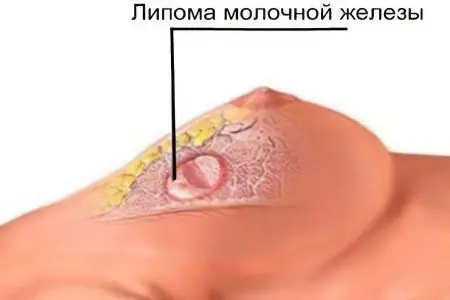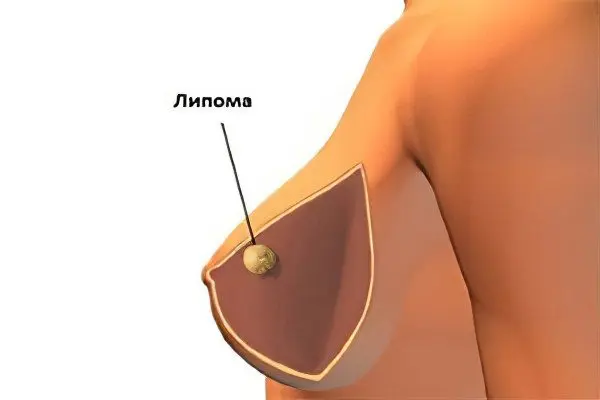Contents

Lipoma of the mammary gland is a benign neoplasm, which is represented by fat cells and is enclosed in a dense capsule of connective tissue. Lipoma is most often diagnosed in women between the ages of 30 and 50. Men are also prone to the formation of this type of tumor, but the lipoma is located in them not in the thickness of the breast tissue, but in the subcutaneous fatty tissue.
Breast lipomas are most often small and grow very slowly. The average size of such a neoplasm is equal to 2 cm, but sometimes it can reach 10 cm in diameter and even more. Although such tumor growth is extremely rare. Lipomas do not hurt, are not soldered to the skin and are quite mobile. However, self-diagnosis is not possible. To clarify the nature of the tumor, you need to contact a specialist.
Types of lipomas of the mammary gland

There are several types of breast lipoma.
Depending on what kind of cells the tumor is represented, there are:
Myxolipoma – adipose tissue predominates in these tumors, but there are also inclusions of mucus that the lipoma itself produces.
Fibrolipoma – in such a tumor there is very little adipose tissue, but a lot of connective fibers.
Angiolipoma – in such a tumor, in addition to fat cells, there are also multiple blood vessels.
Myolipoma – the tumor is dominated not by fat cells, but by muscle fibers.
Lipofibroma – there are few connective tissues in such tumors, they are mainly represented by fat cells.
Depending on the location of the lipoma, there are:
superficial lipomas.
Intermuscular lipomas.
Subcutaneous lipomas.
There are also diffuse and encapsulated tumors. The former do not have clear contours, and encapsulated neoplasms are limited to the fibrous membrane.
Causes of breast lipoma

As for the causes of breast lipoma, which can be called specific catalysts that give rise to tumor growth, they have not yet been identified by scientists.
Nevertheless, risk factors that can provoke the development of neoplasms have been identified, among them:
Disorders in the endocrine system.
Metabolic disease.
Genetic predisposition.
Hormonal imbalance in the body.
Frequent stress.
Overweight.
A sedentary lifestyle that negatively affects the lymphatic outflow in the mammary gland.
Errors in nutrition, with a predominance of animal food in the diet.
Chest injuries of various nature.
Alcohol abuse and smoking.
Numerous births that lead to deformation of breast tissue.
Living in environmentally unfavorable areas.
X-ray irradiation of the breast.
Wearing uncomfortable underwear.
A lipoma in the mammary gland is formed when the lumen of the sweat gland is blocked. The resulting cavity is filled with modified fatty tissue. Most domestic scientists are of the opinion that breast lipomas are the result of a violation in the hormonal sphere.
The development of lipomas in women who have entered menopause is associated with the so-called metabolic syndrome. Its result is the replacement of the glandular tissue of the mammary gland with fatty and fibrous. It is this process that is a prerequisite for the formation of a tumor.
Symptoms of breast lipoma

With palpation of the mammary gland, the tumor can be easily felt, especially if its size reaches several centimeters. As the neoplasm grows, it can be seen during visual inspection. Lipoma looks like a protruding tubercle with a dense texture. Lipoma of the mammary gland does not hurt, but when in contact with underwear, it can cause discomfort.
The tumor is mobile, easily displaced under the skin. The lipoma is not soldered to the surrounding tissues, however, after it is slightly shifted to the side and released, it returns to its original place again.
When the lipoma is represented by lobules, then when the skin is pulled over it, you can see small impressions.
If the lipoma is located in the deep layers of tissues, then it will be impossible to see it. As these deep lipomas grow, they can cause pain as they grow into the muscle fascia and between the muscle fibers.
As a rule, a single tumor is formed in women, which is most often localized under the skin in the upper quadrant of the breast. The more fibrous cells are contained in the neoplasm, the denser it will be.
Diagnostics

To detect a lipoma, the patient needs to contact a mammologist. The doctor performs palpation of the gland, after which he directs the patient for an ultrasound examination.
It can be difficult to make a differential diagnosis during ultrasound, especially for women in the post-menopausal period. The fact is that the mammary gland after 45-50 years is almost entirely composed of adipose tissue (the result of age-related changes in the body) and it is not always possible to “examine” a pathological neoplasm in it, represented by similar cells. The same statement is true for mammography.
Therefore, to clarify the diagnosis, a biopsy of the tumor tissue with subsequent cytological and histological examination of the cells may be required. This procedure distinguishes a lipoma from liposarcoma or breast cancer. Most experts are convinced that only an aspiration biopsy, followed by a histological analysis of the biopsy, will make it possible to make a 100% correct diagnosis. Therefore, doctors refer all their patients to undergo this invasive technique.
Treatment of breast lipoma

Breast lipomas cannot dissolve on their own. Conservative therapy in terms of their elimination is also not effective.
Although lipomas do not transform into cancerous tumors, such neoplasms require close attention from the doctor, especially at the diagnostic stage. If it is confirmed that the tumor is benign and at the same time it is not large, then dynamic monitoring of the patient is possible. At the same time, a woman will have to undergo an ultrasound of the breast every 4 months and do a mammogram 1-2 times a year. Also, during each appointment with a mammologist, he will issue a referral to the patient for blood donation for the CA-15-13 tumor marker, which allows to exclude breast cancer.
When a breast lipoma begins to grow rapidly, puts pressure on blood vessels or nerve tissue, it must be removed. A cosmetic defect is also an indication for sectoral resection, because large lipomas can deform the breast. It should be noted that the rapid growth of a lipoma calls into question its good quality, so the doctor in this case will insist on an operation.
Lipomas are subject to prompt removal. The main method of surgical intervention is a sectoral resection. In this case, the surgeon must be extremely careful not to disturb the tumor capsule during the procedure, removing it completely. Otherwise, the lipoma recurs.
It is also possible to carry out enucleation of the tumor (its exfoliation) or excisional biopsy (puncture or aspiration). In an excisional biopsy, the entire contents of the tumor are removed with a thin needle that is inserted directly into the tumor. This procedure allows you to avoid scars on the chest, but does not make it possible to remove the tumor capsule itself. Therefore, its re-filling cannot be ruled out.
Laser removal of breast lipoma is one of the modern methods of surgical intervention. The procedure is almost bloodless. The seam is performed carefully, the blood vessels are instantly coagulated. The only drawback of this method is its low prevalence. Often, hospitals in small towns do not have specialized equipment that would allow this operation to be performed. Therefore, the gold standard at this point in time is the removal of the lipoma with a scalpel.
Preventive measures

Prevention of lipoma comes down to the following recommendations:
Leading a healthy lifestyle, playing sports. It should be remembered that physical inactivity is a factor leading to weight gain and further health problems.
Carrying out regular self-examination of the breast in the first week after the end of menstruation. Particularly attentive to the condition of the breast should be those women whose closest blood relatives were found to have lipomas of similar localization.
Women over the age of 45 need to undergo a mammogram every two years and visit a mammologist.
If a tumor is found in the mammary gland, it is necessary to seek the advice of a specialist. Lipoma is a benign neoplasm, but it is impossible to distinguish it from breast cancer on its own.
As for the prognosis, it is favorable for breast lipoma. Surgery is not required in every case. Moreover, high-quality surgical intervention with complete removal of the neoplasm capsule makes it possible to guarantee the absence of a recurrence of the disease.









